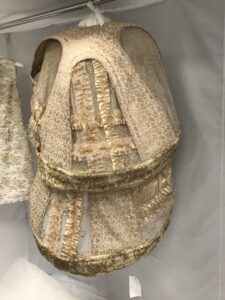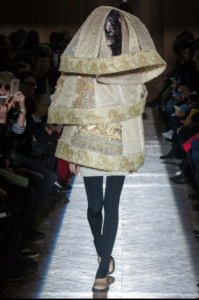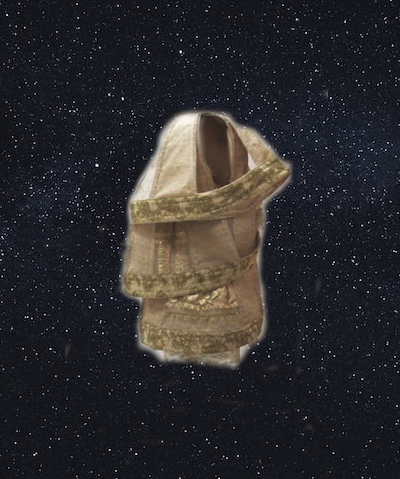A Profane Death in Kawakubo’s Ensemble
Kurt Lemai-Nguyen
Ornamentalism- the forging of the sense of personness through artificial and prosthetic extensions – articulates an allegory for the crisis of personhood that the modern ideal of an integrated, organic, individual person was meant to alleviate. (Cheng 99)

When looking at Rei Kawakubo’s ensemble from her autumn/winter 2015 collection “Ceremony of Separation,” being hung up in the Met’s Costume Institute, the object can not be simply categorized into a type of garment. Rather, using Professor Cheng’s idea of ornaments, they appear like “objects that reference other objects” (Cheng 96). They lack the humanity of normal clothes, in that it is not obvious how the object is worn in the first place – there are no appendages, no holes for arms, and a strict inhuman form, reminiscent of church domes. The ensemble calls more to the image of cathedrals and the architecture of western religion, invoking the grandeur, and consequently the male-dominated power structures within the physical structures. The only indicator of its status as clothing is the cloth material that makes up the vestments worn by the clergy, but also composes the ceremonial altar cloths that are the foundation of rituals, the deliberate operation to stoke veneration. All these attributes are composed with intense labor, whether that be the complex masonry of cathedrals or the ornate gold embroidering, which expresses the physical wealth and social influence of the church, yet also is like Cheng’s race making through “artisanal projects” emphasizing western craftsmanship (Cheng 93). Unlike the porcelain that Cheng reveals as only having their “Chineseness” in common with Asiatic femininity, which is then projected on to Chinese woman, Kawakubo references objects that are directly used by clergy, making the connection closer to an indication from utility than racialization of the objects. Instead of directly calling images of the divine with these items, this power is then centered on the nondescript “aged white clergy male,” who holds the authority, and thus what the authority and the objects representing authority point to. The image of these men although clear also implies their replaceability and the continuity of the power that supports them, not reliant on the individual. It is in this ornament-esque way, “forging of the sense of personness” (Cheng 99) by using the material extension of religious power, that Kawakubo materializes the clergy in the ensemble.
However, Kawakubo does not allow for this power to exist unchallenged. The ensemble only covers the torso, with a funereal mask covering the face, leaving the stockings of the model uncovered, which are today associated with feminine dress unlike the male tights of the past. This exhibition of the legs stands in contrast to the usual vestments, which have the dress extending well beyond the knees, ironically hiding any indication of gender aside from the face. This reversal of gendered display enforces how heavily male-oriented the garment is despite the supposed gender-neutral appearance of vestments. Kawakubo undermines the gendered associations of religious garbs with this move in a paradoxical way, avoiding the nun’s habit by not using a dress silhouette, but still invoking femininity in the stockings. By irreverently imbuing gender in a different style than the church, she coopts the power of the church, granting it someone beyond its traditional members. With her separation of the ensemble into the three sections, she refuses to allow for the smooth uniformity of vestments, physically breaking apart the sensation of oneness. The ensemble is chimeric, where despite the components appearing identical, the stacking makes the ensemble resemble the results of theft, where the perpetrator was trying

to layer as many valuables as possible to take with them, a sacrilegious usurpation that removes the white male clergy from the ensemble. Yet, even more is revealed when we completely remove the ensemble from humanity, to the space farthest from human reach: space. The ensemble – when not on a rack, not on a body, floating in the void – feels divine, as if the absence of mankind accentuates the holiness of the objects they design. The ensemble does not merely drift in space as a soulless thing but claims an identity through its rigid structure and ornate design. However, despite the embellishments pointing the object toward the western Abrahamic God, this God is not the God that made mankind in his image. There is discomfort in having a God whose appearance is not human because it breaks the illusion of the western fatherly deity, the assumed depiction. It is like depictions of Ophanim, who with its flaming wheels covered in eyes subverts the human angel, inducing terror with the thought that such an inhuman entity reigns over humanity. The inorganic composition makes the ensemble not monstrous but bizarre, an entity that even seen, lacks a gender and is not understood. Kawakubo’s jarring layers now free from the vertical confines of gravity begins to invoke a Lovecraftian fear of the incomprehensible, the cosmic that lies beyond human knowledge. The religious adornments now appear like bait with the gold cloth too obviously invoking the sacred. Unlike a possessed object which maintains its original form, the ensemble’s incoherent structure resembles a corrupted copy, a façade that the entity uses to lure in believers and reinforce its presence. The true nature of the God is hidden behind the mutated abstraction of the Christian mythos represented by only the highlights of vaguely Christian aesthetics in the ensemble.
So, what then does it mean for the object which is a broken interpretation of the human representation of divine power, to be an item part of the “Ceremony of Separation,” the boundary of death? Kawakubo uses the ensemble to question one’s reliance on faith at the loss of a loved one. She warns about who the target of faith actually is within the church, where the furnishing and objects point more towards the white male clergy who use and wear these items, than a God. Although one may be able to steal and embody this power, it comes at the cost of individuality, with the ensemble covering the body and its shape. It is in space that we can see that the criticism extends further to question the nature of divinity itself. How are humans so assured that they can identify the benevolent God as opposed to the apathetic or malicious God? Is the benevolent God one that must take the form of man, to represent them as a father? Kawakubo calls these questions to reveal the weaknesses of faith, asserting the importance of individuality.
Works Cited
Cheng, Anne Anlin. Ornamentalism. Oxford, New York: Oxford University Press, 2019.
Kawakubo, Rei. Ensemble, fall/winter, 2015–16, 2015.635a–e. The Metropolitan Museum of Art, New York.
Nast, Condé. “Comme Des Garçons Fall 2015 Ready-to-Wear Fashion Show.” Vogue. Accessed December 6 , 2022. https://www.vogue.com/fashion-shows/fall-2015-ready-to-wear/comme-des-garcons/slideshow/collection.
I pledge my honor that this paper represents my own work in accordance with University regulations.
Kurt Lemai-Nguyen.

